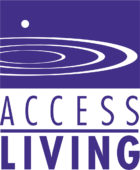Post COVID Workplace Accessibility: Where Are Our Allies?
Guest Blog Post Written by Laura Isaacs
It’s long past time for true disability acceptance and accessibility in professional spaces
Editor’s Note: Laura Isaacs is a career executive assistant with over 20 years of experience in various industries including law, professional services and human resources. Laura is a friend of Access Living, a member of ADA 25 Advancing Leadership and is a passionate advocate for disability and mental health accessibility in the workplace. She is an E/BRG subject matter expert and speaks frequently about her experience with invisible disabilities.
As we look to a post COVID way of life, I know I’m not alone in wondering what the future landscape of remote work will look like. I’ve been a disabled person in the workforce for almost my entire career, constantly working to adapt and too often not accommodated. Although I didn’t really start publicly presenting my disability status for what it was until about seven years ago, I have still found myself in situations where I had to adapt.
The pain in my legs started in Spring of 2013. I wrote it off at first thinking ,“I’m out of shape.” But then I started losing feeling in my left leg. After a number of tests and trying more pain medications than I could count, I was diagnosed in 2016 with Fibromyalgia and Chronic Fatigue Syndrome in addition to the autoimmune disease I already had and the IBS I was diagnosed with in 2007. This was a different type of illness, though; because my pain was here to stay.
I’ll never forget a conversation I had with my manager at work a few years later. I often have doctor’s appointments during the day, and at the time I came up with a solution I thought would work well. I’d come into the office early on days I had to leave for an appointment so I could still work a full eight hours.
“If I do that for you, I’ll have to do it for everyone,” my manger said, all while claiming to sympathize, and still remaining unwilling to allow me to manage my illness and still be an effective employee.
Historically, true accessibility and inclusion for people with disabilities in the workplace has been almost non-existent. As technology advanced, we were hopeful it would offer us more employment and educational opportunities, but the technology itself was not always accessible and adoption of flexible work from home policies was slow.
The COVID-19 pandemic forced a vital workplace shift when suddenly everyone had to work from home and reinforced to the disability community that working from home is actually a viable option, despite what we’ve been told for years. The country turned on a dime and millions of people traded in their morning commutes and offices for video conferences.
The question now is, do we wait for things to shift back to structured work days and red tape if a work from home situation is needed; or, do we adopt a new standard that says, “of course this office is fully accessible because it’s the right thing to do.” A standard wherein someone who is better accommodated at home due to disability is as much a part of the team as the employee who works 60 hours a week in the office. We continue to make our voices heard online, in blogs, on podcasts, and whatever other media we can use to gain our civil rights. Because that’s the bottom line: disability access to workplaces, schools, voting booths and so many other places where we are denied access, are all civil rights. And we demand that our non-disabled allies raise their voices with us for true disability acceptance and accessibility in professional spaces.
